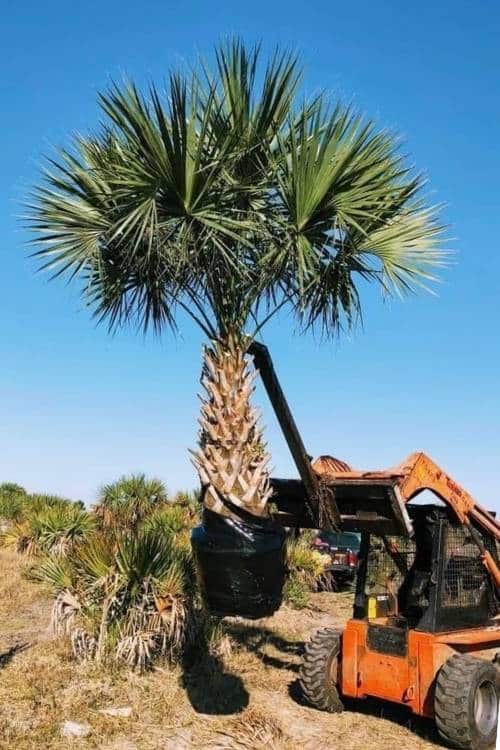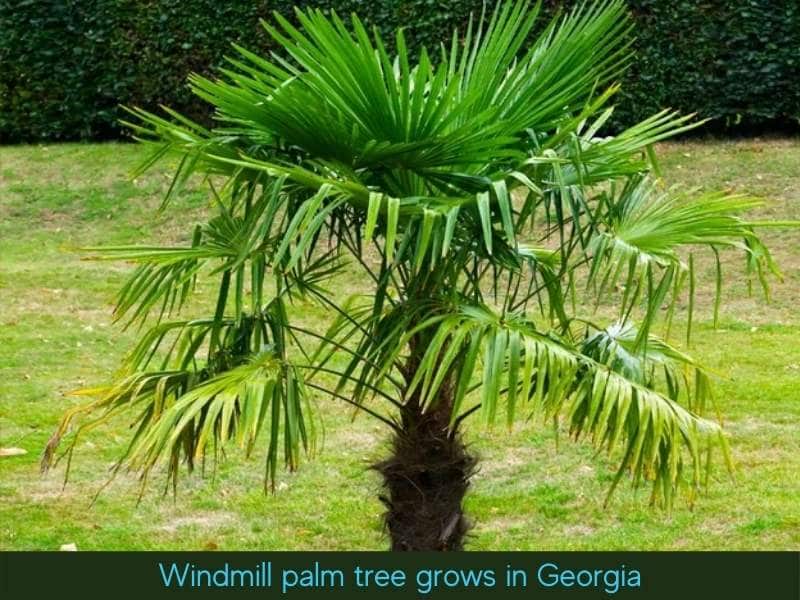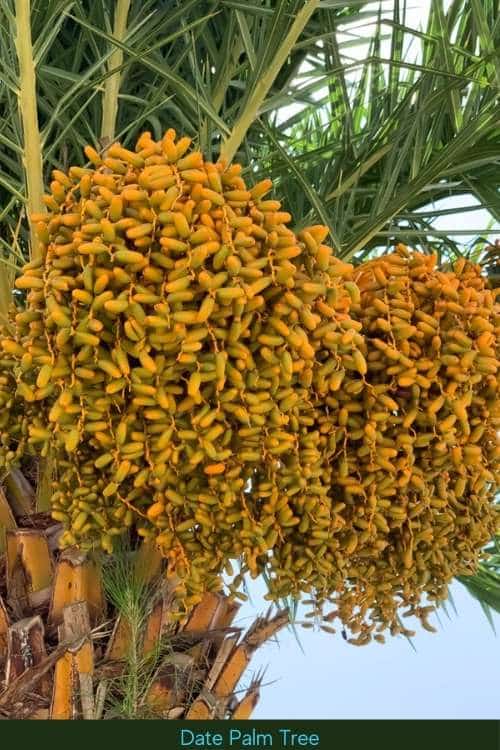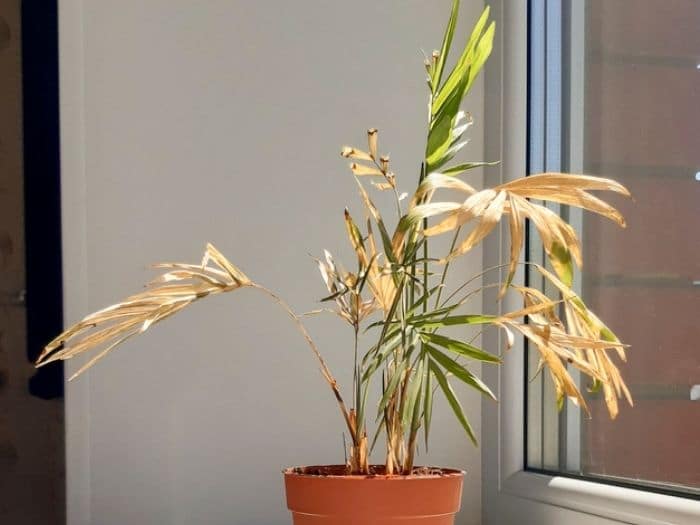9 Palm Trees in Georgia and Atlanta Area + Planting Zones
Palm trees are native to tropical regions so it may seem strange that these trees grow naturally all over Georgia. They were introduced years back and have been thriving ever since.
Some of the palm trees in Georgia and the Atlanta area include the sabal palm, windmill palm, needle palm, saw palmetto, true date palm, Canary Island date palm, and the pindo palm. Most of these trees can survive the cold winters common in Georgia.
Are there palm trees in Georgia?
There are many varieties of palm trees in Georgia even though the trees are not native to this state. Being a USDA Hardiness Zone 7 to 8, Georgia experiences mild winters and warm summers in which some varieties of palm trees and palmettos grow and thrive.
The humid subtropical climate that is present in most of the state ensures palm trees grow here when given good care and excellent soil drainage. However, most palms in the state of Georgia do not grow as tall as those in Florida where the climate is much more suitable for these trees to grow.
What palm trees grow in Georgia?
If you drive along some of Georgia’s popular streets, you’ll notice some palm trees lining them for great aesthetics. It means these trees can also grow in your yard but with proper care
While indoor palm trees are easy to care for and grow anywhere, outdoor conditions can be difficult to control. Therefore, you need to choose from cold-hardy palm trees that thrive in different USDA hardiness zones to grow them successfully.
Here are the palm trees varieties found in Georgia:
1. Cabbage Palm (Sabal palm)

The sabal palm, also called the cabbage palm trees, is native to Georgia and can be seen growing and thriving in homes, streets, and tropical gardens. It belongs to the Arecaceae family and is part of the 15 different palms of the palmetto palm.
Cabbage palms in Georgia produce curved leaves about 3–4 feet long that appear to be fan-shaped. The flowerheads extend outside the leaf canopy and can produce many tiny, creamy-white, fragrant flowers that are known to attract flowers.
Being winter-hardy plants, sabal palms found in Georgia rarely reach 90 feet tall, but it is common to see those that are about 40-50 feet in height when growing erect.
2. Windmill palm

The windmill palm is one of the most cold-hardy palms you can find growing in the state of Georgia. It can survive in cold weather, up to 10-degrees F. or lower. Although it is native to China, it grows and thrives well in Georgia and can be found along the streets of Atlanta.
The Windmill palm can grow up to 40 feet tall but it is normally seen as a much smaller size ranging 10-20 feet. The root ball of the palm tree does not grow too deep, meaning you can grow it in your yard.
Note that some of the common palm tree diseases affecting windmill palms include lethal yellowing disease, root rot, and leaf spots. You might want to consider these when growing the tree in your Georgia residence.
3. The Needle Palm

The needle palm is another common tree found in Georgia. It is native to the south Atlantic states of the United States, which include Georgia, North and South Carolina, etc.
- USDA Hardiness zone: 5b (-15 to -10 F) to 11 (above 40 F)
- Sunlight – partial shade to full sun
The needle palm is extremely hardy and will survive very cold temperatures down to -15F. It is recommended for USDA zone 5b to 11, so you can grow it in Georgia successfully.
It is one of the shorter types of palm trees found in Georgia and the states around the south Atlantic. If you don’t want to grow the saw palmetto, you can try the needle palm as they bear a lot of resemblance, except that most people consider it a prettier version.
4. Saw palmetto (Serenoa repens)

The saw palmetto is native to Florida and other southeast states. It is often found growing in some parts of Georgia and unlike the other tall trees, the saw palmetto has a clumping growth pattern, so it requires frequent pruning to maintain its shape.
While you’ll notice plenty of pine trees on the highways of south Georgia, just beneath them grow saw palmettos in clumps.
- USDA hardiness zones 8 to 10
- Great in full sun
- Drought tolerant when established
Saw palmettos will prefer to grow in full sun, but you can successfully plant them in any light conditions. They grow slowly and can only reach a height of 2 to 7 feet tall.
5. Dwarf palmetto (Sabal minor)
The dwarf palmetto is native to the southeastern United States, from the Carolinas south to Florida and west to Texas. It is often seen on golf courses and other commercial landscaping in Georgia as a ground cover that grows to 5-10 feet tall.
The palmetto is also known by its Spanish name of Sabal minor, is extremely hardy to cold and frost among all the palm trees of North American origin.
The recommended USDA hardiness zones for the dwarf palmetto are USDA zones 7-10, so it grows and tolerates the cold winter temperatures as low as 14°F common in Georgia just fine.
Dwarf palmetto is a low-maintenance palm tree and has been used for fencing, but you can grow it as an ornamental in your yard with minimal care.
6. Mediterranean Fan Palm
The mediterranean fan palm is another great palm tree of Georgia that’s known for its fast-growth rate, producing multiple trunks.
Also known scientifically as, Chamaerops humilis, this palm is a very cold-hardy palm tree that can tolerate up to 10 degrees. Since this palm grows at a fairly fast rate of 12 inches per year, it is suitable for developing landscapes and is commonly seen in some areas of Georgia and even Texas.
7. True Date Palm Tree

The true date palm is also referred to as Phoenix Dactylifera. It is known to grow and do well in states like Georgia, Arizona, Alabama, Louisiana, etc.
While it is a winter hardy date palm tree, I wouldn’t recommend you grow it in your yard as it reaches heights above 50 feet. As such, it is a giant and can easily dwarf other plants in your home.
- USDA hardiness zone: 8b (15 to 20 F) to 11 (above 40 F).
- Winter tolerance: As low as 15F
While this tree can tolerate drought, it does not do so well in areas with very high humidity. That’s why it is not a common sight in Florida as it is along the highways of Georgia.
8. Canary Island Date Palm Tree
The Canary date palm is a flowering palm tree native to the Canary Islands. It can grow as tall as 40–50 feet, so it is not the best to plant in your yard as it will outgrow most other trees around it.
However, the canary island date palm is one of the slowest growing palm trees, though not as slow as the coco de mer palm.
The canary island date palm is suitable for USDA Hardiness Zones 9A–11 (> 20°F) and is one of the common palm trees in Georgia. You can also find it in coastal Southern Carolina, Florida, Mississippi, Alabama, Lower Texas, and Louisiana.
9. Queen Palm Tree
The queen palm tree is one of the most popular trees in Georgia. It can grow up to 40 feet high and have a spread that reaches out about 20 or more feet wide. They are dense, slow-growing but very attractive with their dark green leaves and thick trunk.
Queen palms do not naturally grow well in USDA zone six because they prefer a warmer climate, but you can grow one in USDA zones seven through ten.
If you live close to the coast and are looking for a tree that will both provide shade and give your yard an exotic feel, then this is just what you need. They are very popular trees on islands because they make great windbreaks too.
Atlanta Palm Trees
The most common palm trees in Atlanta, Georgia are the windmill palm tree, the pindo palm, the European fan palm tree, and the Chinese fan palm. Since Atlanta is in the USDA hardiness zones 7b and 8a, these palm trees can survive cold winter temperatures ranging from 5°F to 15°F.
You can grow some of the shorter varieties of these palm trees in the Atlanta area, but provide them with proper care and maintenance.
Where in Georgia are there palm trees?
Many people think that palm trees only grow in tropical climates. However, there are actually some palms found throughout the state of Georgia! The most common species is the cabbage-palm (Sabal palmetto).
You can find these tall and stout plants on barrier islands along coastal regions or near wetlands inland in Georgia. They thrive where there’s freshwater to drink and plenty of sunlight to soak up all day long.
Some of the palm trees in Zones 8b -11 in Georgia include Phoenix canariensis, Canary Island date palm (Phoenix canariensis), the Medjool Date Palm (Phoenix dactylifera), and Mexican fan palm.
In USDA zones 8a – 11 (10 to 15 F), you will find palm trees such as the Phoenix canariensis, Canary Island date palm (Phoenix canariensis), the Medjool Date Palm (Phoenix dactylifera), and Mexican fan palm (Washingtonia robusta).
Conclusion
Georgia is bordered to the north by Tennessee, to the northwest by Alabama, and to the south by Florida. You’d expect to find many palm trees lining Florida, but to the surprise of many, Georgia also has palm trees.
Palm trees in Georgia are a common sight, but their origin is not. The state has been home to palm tree forests for centuries.
Whether you’re looking at the tall palms lining the streets of Savannah or enjoying a day by the Atlantic Ocean on Tybee Island, there’s no denying that these trees provide beauty and charm in addition to shade from Georgia’s hot sun.
References:
- Edward F. Gilman and Dennis G. Watson, Trachycarpus fortunei – Windmill Palm.
- https://aggie-horticulture.tamu.edu/galveston/educ_programs/Cold-Hardy-Palms.pdf


![Palm Tree Roots – How Deep Do They Grow? [Facts]](https://gardenine.com/wp-content/uploads/2021/03/Palm-tree-root-system-diagram.jpg)


Here in Northwest Georgia. People are having great success with Pindo palms also. I think they need some notoriety.